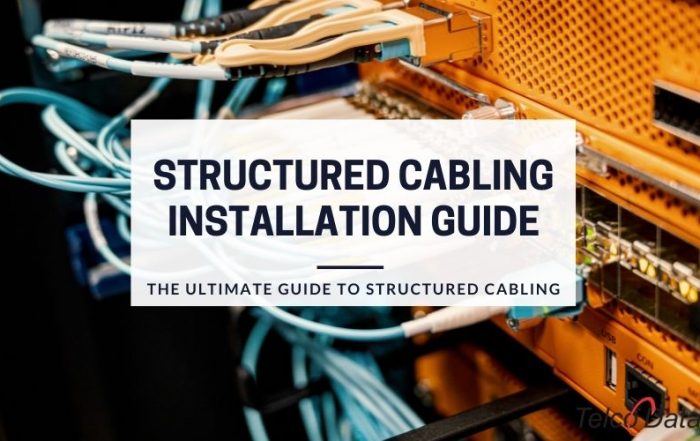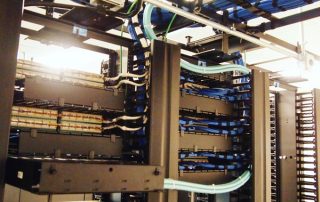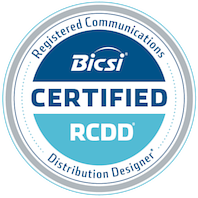Looking to get structured cabling installed? Whether you’re building out a new office or you’re looking to upgrade your current network, structured cabling lays the groundwork for reliable, fast communications. The benefits of structured cabling are many: flexibility, reliability, scalability, aesthetics, and more. Keep reading to learn more about structured cabling installation in commercial buildings and offices!
What is Structured Cabling?
Structured cabling is an organized system of low voltage wiring that connects a multitude of devices to your network: computers, copiers, printers, security cameras, telephones, intercoms, and more. The structured cabling system may be made up of copper wire or fiber wire and it also includes patch panels, trunks, and other components.
It may be useful to compare structured cabling to the central nervous system. Your body’s nervous system uses a network of nerves to connect the body to the brain. Your nerves transmit information throughout your body. It’s very similar to how structured cabling connects devices to the network in a systematic, organized way to transmit data, voice, audiovisual, and more.
Is All Network Cabling Structured Cabling?
Not all cabling is structured cabling. Chances are, you’ve dealt with messy or disorganized network cabling in the past – whether that means you dealt with it firsthand while trying to make sense of which cable went where, or you simply dealt with the consequences of unstructured cabling. Most of us have dealt with a slow or unreliable network connection. Disorganized cabling systems are often difficult to modify and may result in unreliable connections.
The Parts of a Structured Cabling System
For a low voltage cabling system to be considered “structured,” it is essential to combine the components in an efficient, organized way that makes sense for the unique application. No two structured cabling systems are alike. There are six main components that make up a structured cabling system, as follows:
- Horizontal Cabling
- Vertical Cabling
- Entrance Facility
- Consolidation Point
- Telecommunications Enclosure
- Work Area Components
6 Components of a Structured Cabling System
- Horizontal cabling makes up the majority of the cabling in the system. These wires will connect your work area outlets to the main hub. Each cable will end in a termination, where it connects to a device. Horizontal cabling also includes the outlets that phones and computers are plugged into along with transition points where two different types of cables connect to one another. Cross connections using jumpers and patch cords are also commonly found as a part of the horizontal cabling subsystem.
- Vertical cabling makes up the “backbone” of the structured cabling system. It offers interconnections between different spaces. Vertical cabling also includes the cable routing components that make your structured cabling look neat and organized, including conduits and raceways.
- You’ll also have entrance facility cabling, which is where your building connects either to an outside telecommunications provider or to a private network. If you have multiple buildings in the same system, you will have entrance facility cabling connecting the different buildings.
- Your telecommunications enclosure (or room, or closet) is the termination and cross-connection point for all the horizontal and vertical cabling in your structured cabling system. You’ll generally have multiple components here including connecting equipment, auxiliary equipment, and more.
- Not all buildings have a consolidation point, but larger networks may have an environmentally-controlled equipment room to house routers, servers, and more.
- And lastly, there are the work area components, which is the part of the structured cabling system that is most visible as it’s the part that employees are directly interacting with. Workstation equipment includes anything from computers to desk phones to printers and much more. Work area components include outlets, patch cables, PC adapters, and more.
Factors to Consider for Structured Cabling Installation
Every structured cabling system is unique. Here are some of the factors that need to be considered any time you’re installing low voltage wiring in an office or other commercial space.
- What is the layout or floor plan of the interior space? Your cable runs will be determined by the floor plan and the location of each work station.
- What is the size and structure of the building or campus? You’ll need to determine how to efficiently plan out the system based on the size and structure of the space.
- What are your current needs? Do you currently just have a few work areas or do you have hundreds that all need to be connected?
- What do you anticipate your future needs to be? Is your company expected to grow significantly? Are there new technologies on the horizon that you need to be prepared for while installing a structured cabling system?
Installing Cabling for High-Speed Internet
For a fast, reliable internet connection, ethernet is still a great solution. An ethernet cable installation is common in offices and it may include any number of routers, PCs, and other equipment. There are several different categories of ethernet cabling, so you’ll want to work with your installer to determine the best category of cabling for your local network. Your selection will depend on the length of cable runs, the number of people using your network, how fast your internet needs to be, and your budget.
Fiber optic internet is another great solution for high-speed internet over long distances. It is different than ethernet because the cable contains glass strands instead of copper wire, and the data is transmitted via light instead of electrical currents.
Choosing the Right Installer for Your Structured Cabling
The most important thing to consider is who you’re going to hire to install your structured cabling. They’re not just installing the cables. They’re also designing your network so that it functions optimally, scales easily, and can be upgraded or modified in the future.
At Telco Data, we employ a team of highly-trained voice and data cabling installers. We would be happy to guide you through your options and provide you with the best structured cabling services in Texas!
Structured Cabling Installation FAQs
What is structured cabling?
Structured cabling consists of an organized system of wires and associated hardware. It can transmit data through a network, provides telephone service, and more.
Do I need structured cabling?
Structured cabling is beneficial for businesses of all sizes. To know for sure how you can benefit from structured cabling, schedule a free site survey with Telco Data.
How much does structured cabling cost?
The price will vary drastically depending on the size of your building, your floor plan, and several more factors. A free estimate from Telco Data will help you determine the cost of a custom cabling solution. Schedule one today!
Does structured cabling need to be installed by a professional?
The point of structured cabling is to be as efficient and organized as possible. Without the professional expertise of a structured cabling installer, you could run into major problems including costly downtime. Additionally, wiring is subject to a variety of standards and regulations that pros are highly familiar with.







